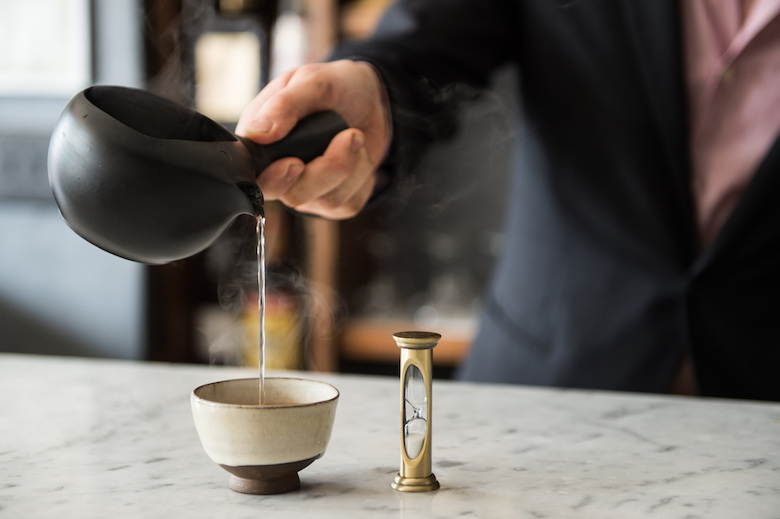
Although the tides are changing in the city, tea is still an afterthought for many New Yorkers. Jeff Ruiz, the beverage director of Olmsted, the popular restaurant in Prospect Heights that’s garnered two stars from the New York Times and was a semi-finalist for “Best New Restaurant” at this year’s James Beard awards, hopes to remedy that.
“In the U.S., tea is used as a catchall phrase for anything you steep in hot water, and that’s the biggest roadblock I think we have to developing a tea culture in the U.S.,” says Ruiz. “A tea and a tisane (herbal infusion) are totally different beverages. That’s like saying wine and whiskey are in the same category because they both have alcohol.”
Ruiz sees huge possibilities for tea education in the U.S., which is one of the reasons he’s so passionate about it. “The tea leaf is the only other plant that can rival or exceed the range you get on the palate with wine,” he opines, no mentioning coffee, chocolate or other complex foods.
Olmsted even has a tea plant in their outdoor garden to remind customers where tea actually comes from. “I think that’s another thing that affects the culture here—we don’t see tea plants—tea is just in a box in the grocery store,” Ruiz says.
Prior to joining Olmsted, Ruiz was the tea curator at fine dining destination Atera. He transformed their tea program through meticulous research and subsequent “tea epiphanies,” making Atera’s tea service one of the best in the country. And now he’s brought that knowledge and excellence to Olmsted, praised as much for its stellar food as its affordable prices.
At Olmsted, Ruiz sources high-quality teas from multiple importers from the world’s best regions—like Yunnan (China), Yame (Japan) and Darjeeling (India) and sells them at the relatively affordable price of $4.00 a pot. High-quality teas at an accessible price opens the door for people who can’t afford a meal and tea service at places like Eleven Madison Park but want something beyond Tazo.
For Ruiz, the vessels and service are also just as important as the product. Each lidless, open-topped clay teapot comes with large and small clay cups and an hourglass timer. The server will explain that when the timer is up, you should pour all of the tea into the larger cup with a spout, and then pour yourself small cups from there.

Typically at an Olmsted-level restaurant, you’ll be given a pot filled with hot water and tea and a cup, says Ruiz. “They don’t tell you how long you should steep it, so when you pour out those last few drops, they’re probably over-extracted. So the last sip you have in the restaurant ends up being bitter. Is that what you want to do in a restaurant setting?” he asks incredulously. “To leave someone with a bitter taste in their mouth?”
Because tea is something where the customer participates in its preparation, there is a lot of room for error. To combat that, Ruiz realized that he had to keep things as systematic and foolproof as possible. The timer, unique to Olmsted, is part of that, but he even considered the possibility that the customer might not notice when the timer runs out.
“That’s the main reason we went with an open-topped teapot design,” Ruiz explains. “Because of the open top, there’s some leeway to the extraction—the heat dissipates faster so the rate of extraction goes down as time goes on,” making for a lower chance of that last sip being bitter.
“If you want to have that tea epiphany that I had years ago,” says Ruiz, “You can have it here at Olmsted.”



